A wireframe is a simplified visual guide that outlines the basic structure and layout of a web page or application. It focuses on functionality, user flow, and content placement rather than design details. Wireframes help stakeholders visualize the interface and make early decisions before development begins.
Wireframes are not just about looks—they’re about functionality. They ensure that every button, image, and text block has a place while outlining the user flow.
Beyond offering a skeletal structure, wireframes:

For example, Tenet uses wireframes as a foundation when designing user-friendly apps or engaging websites during services like custom CMS development or cross-platform app development.
By starting with a basic wireframe, the team ensures that every project meets client requirements seamlessly.
There are two main types of wireframes:
The designers at Tenet excel at creating both high and low-fidelity wireframes as part of their extensive product design and brand research services. This ensures every stage of your app or website project proceeds efficiently.
Wireframes are the unsung heroes of digital product development, offering several benefits:
Wireframes typically include:
When working with a UI/UX design company like Tenet, your wireframe navigates the functional and structural aspects first, making sure it aligns with your vision from day one.
Designing a wireframe isn’t just about throwing shapes onto a digital canvas. There’s a systematic process:
With Tenet's design audit services, this approach ensures both the visual integrity and functional efficacy of your design blueprint.
Not at all! Wireframes can guide the development of a range of digital products, including SaaS platforms, dashboards, and even cross-platform apps.
In industries like mobile app development, wireframes also serve as a foundation when working with challenging interfaces or complex data arrangements.
A wireframe is only the first step. Once approved, it evolves into a prototype. Prototypes are more dynamic—they illustrate not only structure but also interactivity and functionality.
For example, buttons work, and page transitions can be experienced. These prototypes often lead directly into the development phase.
Wireframes allow clients to visualize their product early on, giving them the confidence to move forward with development.
For example, Tenet's high client satisfaction rate (98%) stems from their ability to align client expectations from the get-go using actionable wireframes.
This makes it easier to showcase how business needs like improved conversion rates or enhanced navigation will be addressed.
It depends on the project's complexity. If you're launching a simple blog, you might skip the wireframing phase. But for intricate projects like Android app development, SaaS development, or custom CMS development, wireframes are indispensable.
A wireframe is more than a starting point—it’s a strategic tool that lays the foundation for the entire digital product’s journey.
At Tenet, we make wireframes a cornerstone of our website development and UX research processes, ensuring client goals take shape with precision.
Whether you’re developing an app or creating next-level digital experiences, a strong wireframe can make all the difference.